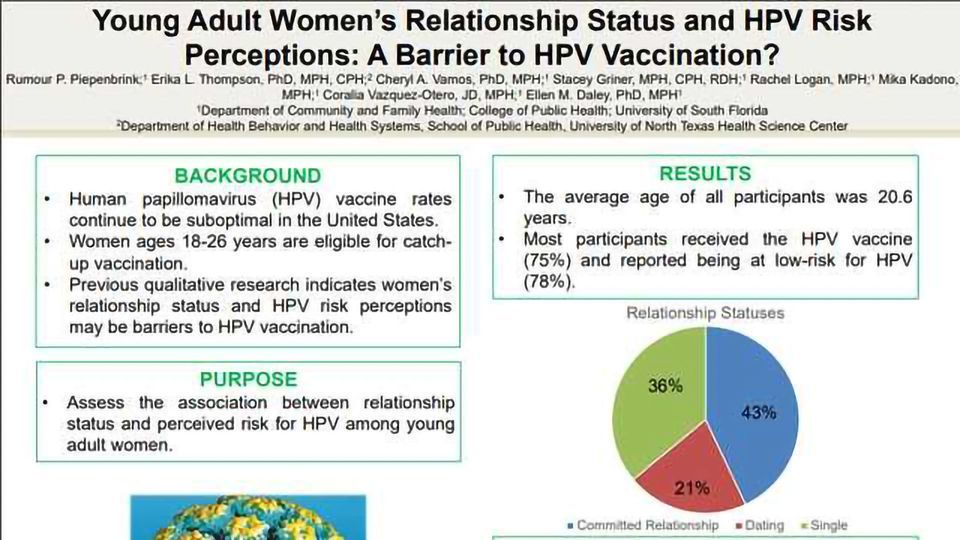Young Adult Women’s Relationship Status and HPV Risk Perceptions: A Barrier to HPV Vaccination?

Background: Human papillomavirus (HPV) vaccine rates continue to be suboptimal in the United States. Women ages 18-26 years are eligible for catch-up vaccination, yet previous qualitative research indicates women’s relationship status and HPV risk perceptions may be barriers to HPV vaccination. Quantitative studies are needed to expand the generalizability of these findings. The purpose of this study was to assess the association between relationship status and perceived risk for HPV among vaccinated and unvaccinated young adult women.
Methods: Women aged 18-26 years at a Florida university completed an online survey in November 2016-April 2017 (n=305). The survey assessed HPV vaccination status, perceived risk for HPV, and current relationship status. Logistic regression models estimated the odds of perceived high-risk for HPV stratified by vaccination status in SAS 9.4.
Results: Participants reported the following relationship statuses: committed relationship (43%), dating (21%), and single (36%). Most participants received the HPV vaccine (75%) and reported being at low-risk for HPV (78%). Among unvaccinated women, relationship status and HPV risk perception were significantly associated (p=0.01). Specifically, women who were dating were more likely (OR=5.33, 95%CI 1.16-24.5) to perceive a high-risk for HPV compared to women in a committed relationship. No effect was found for relationship status and HPV risk perception among vaccinated women.
Conclusion: Findings corroborate the association between relationship status and HPV risk perceptions among unvaccinated women. Specifically, women in relationships were less likely to perceive themselves at high-risk for HPV, which may not be an accurate assessment given the high prevalence of HPV among young adults. This association is not present for vaccinated women, which may indicate relationship status and risk perceptions are barriers to HPV vaccine uptake. Future research should develop and test health communication messages to address HPV risk misperceptions among young adult women in relationships to promote HPV vaccination.
Methods: Women aged 18-26 years at a Florida university completed an online survey in November 2016-April 2017 (n=305). The survey assessed HPV vaccination status, perceived risk for HPV, and current relationship status. Logistic regression models estimated the odds of perceived high-risk for HPV stratified by vaccination status in SAS 9.4.
Results: Participants reported the following relationship statuses: committed relationship (43%), dating (21%), and single (36%). Most participants received the HPV vaccine (75%) and reported being at low-risk for HPV (78%). Among unvaccinated women, relationship status and HPV risk perception were significantly associated (p=0.01). Specifically, women who were dating were more likely (OR=5.33, 95%CI 1.16-24.5) to perceive a high-risk for HPV compared to women in a committed relationship. No effect was found for relationship status and HPV risk perception among vaccinated women.
Conclusion: Findings corroborate the association between relationship status and HPV risk perceptions among unvaccinated women. Specifically, women in relationships were less likely to perceive themselves at high-risk for HPV, which may not be an accurate assessment given the high prevalence of HPV among young adults. This association is not present for vaccinated women, which may indicate relationship status and risk perceptions are barriers to HPV vaccine uptake. Future research should develop and test health communication messages to address HPV risk misperceptions among young adult women in relationships to promote HPV vaccination.




